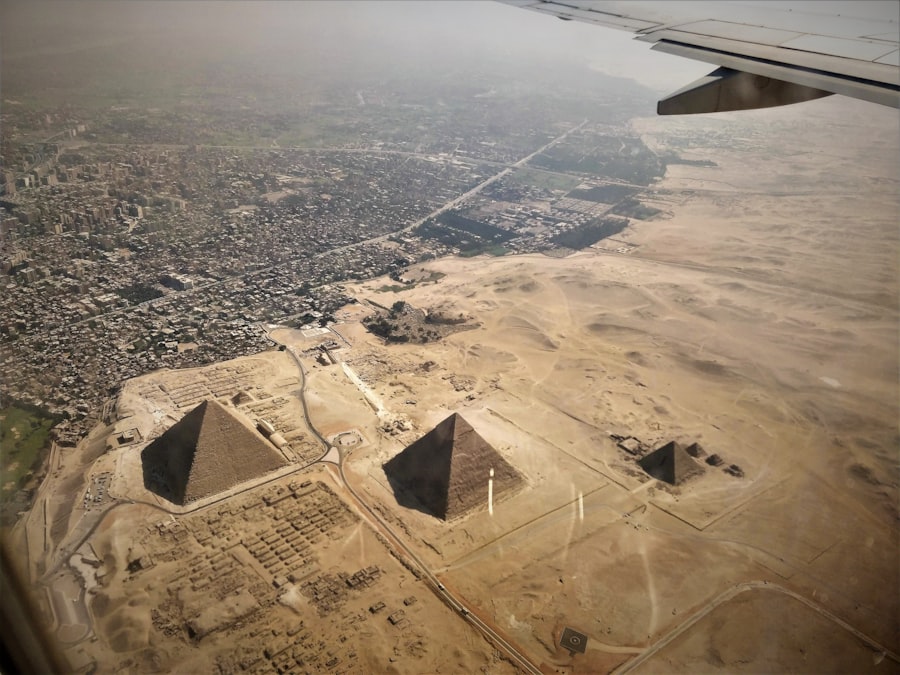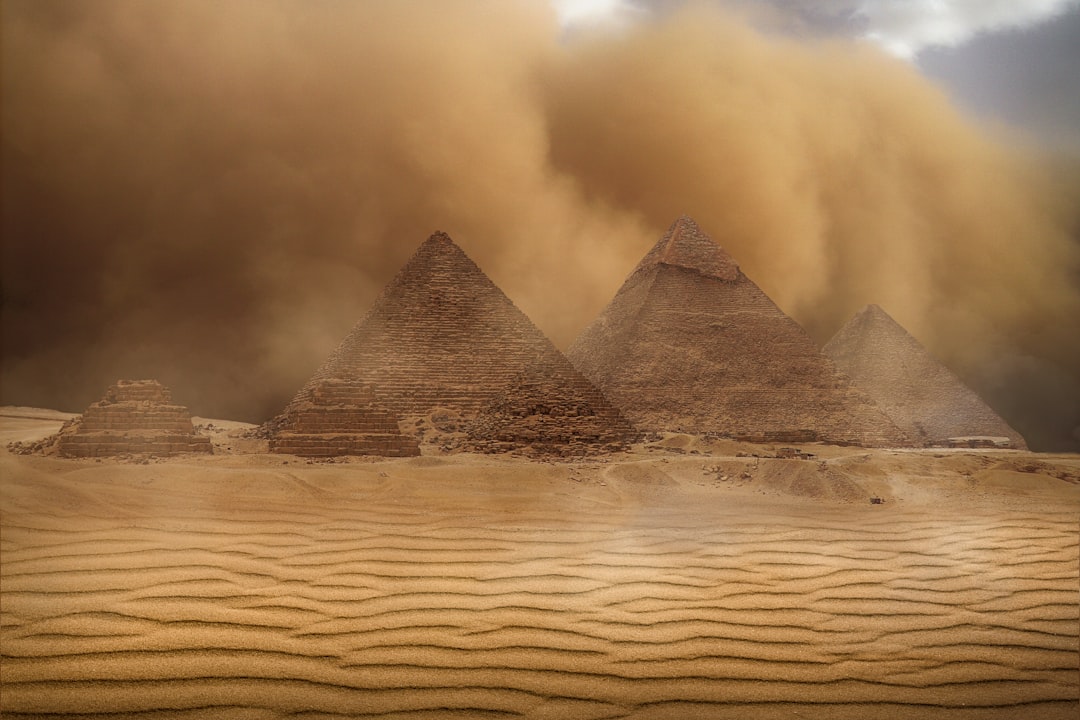The Great Pyramid of Giza, an iconic symbol of ancient Egypt, stands as a testament to the ingenuity and ambition of a civilization that flourished over 4,500 years ago. Constructed during the Fourth Dynasty of the Old Kingdom, this monumental structure was built as a tomb for Pharaoh Khufu, also known as Cheops. Towering at an original height of approximately 146.6 meters, it was the tallest man-made structure in the world for over 3,800 years.
The pyramid’s sheer scale and precision have captivated historians, archaeologists, and tourists alike, making it one of the most studied and visited monuments in human history. The Great Pyramid is not merely a tomb; it is a complex architectural marvel that reflects the advanced understanding of mathematics and engineering possessed by the ancient Egyptians. Its construction involved millions of limestone blocks, each weighing several tons, meticulously arranged to create a structure that has withstood the test of time.
The pyramid’s design and construction techniques continue to be subjects of fascination and debate, prompting various theories about its purpose and significance beyond its role as a royal burial site.
Key Takeaways
- The Great Pyramid is the largest and most famous of the pyramids in Egypt, built as a tomb for the Pharaoh Khufu.
- Theories about the purpose of the Great Pyramid range from serving as a tomb to being an astronomical observatory or a power plant.
- The advanced engineering of the Great Pyramid is evident in its precise construction and alignment with the cardinal points.
- The lack of funerary items in the Great Pyramid challenges the traditional belief that it was built as a tomb.
- The alignment of the Great Pyramid with celestial bodies suggests a deeper astronomical significance.
- Theories about the Great Pyramid’s alignment with Orion’s Belt propose a connection to ancient Egyptian beliefs and mythology.
- The inner chambers and passages of the Great Pyramid are a subject of fascination and mystery, with various theories about their purpose and function.
- Alternative theories about the purpose of the Great Pyramid include it being a center for spiritual initiation or a repository of ancient knowledge.
- The Great Pyramid’s connection to ancient knowledge and technology is a topic of ongoing research and speculation.
- Reconsidering the purpose of the Great Pyramid leads to a deeper appreciation of its significance in ancient history and its potential role in unlocking ancient mysteries.
Theories about the Purpose of the Great Pyramid
While the prevailing belief is that the Great Pyramid served as a tomb for Pharaoh Khufu, numerous theories have emerged regarding its true purpose. Some scholars argue that it was not only a burial site but also a symbol of the pharaoh’s divine power and a means to facilitate his journey to the afterlife. This perspective suggests that the pyramid was designed to help Khufu ascend to the heavens, reinforcing the connection between the pharaoh and the gods.
The grandeur of the structure may have been intended to reflect Khufu’s status and ensure his immortality. In contrast, other theories propose that the Great Pyramid served a more practical function. Some researchers suggest that it may have been an astronomical observatory or a center for religious rituals.
The precise alignment of the pyramid with cardinal points raises questions about its potential role in ancient Egyptian cosmology.
Evidence of Advanced Engineering in the Great Pyramid

The construction of the Great Pyramid showcases remarkable engineering prowess that continues to astound modern architects and engineers. The precision with which the stones were cut and assembled is evident in the pyramid’s nearly perfect alignment with the cardinal directions. Each side of the base is oriented within a fraction of a degree of true north, south, east, and west, demonstrating an advanced understanding of geometry and astronomy.
Moreover, the techniques employed in transporting and lifting massive stone blocks are still subjects of research and speculation. Theories range from the use of sledges and lubricated surfaces to sophisticated ramp systems that allowed workers to elevate stones to great heights. The sheer scale of labor required for such an undertaking indicates a highly organized workforce, suggesting that ancient Egyptians possessed not only advanced engineering skills but also effective management systems to coordinate thousands of laborers.
Lack of Funerary Items in the Great Pyramid
| Location | Funerary Items | Discovery |
|---|---|---|
| King’s Chamber | Empty | Explored in 1837 by Howard Vyse |
| Queen’s Chamber | Empty | Explored in 1872 by Waynman Dixon |
| Subterranean Chamber | Empty | Explored in 1818 by Giovanni Caviglia |
One of the most intriguing aspects of the Great Pyramid is its relative lack of funerary items compared to other royal tombs from ancient Egypt. Unlike many other pyramids, which were filled with treasures, artifacts, and offerings intended for use in the afterlife, Khufu’s burial chamber contained minimal items. This absence has led to various interpretations regarding its significance.
Some scholars argue that this lack of funerary goods may indicate a shift in burial practices during Khufu’s reign. It is possible that the focus shifted from material wealth to spiritual preparation for the afterlife. Alternatively, some theorists suggest that grave robbers may have plundered the pyramid shortly after its completion, leading to the scarcity of artifacts found within.
This theory raises questions about the security measures taken by ancient Egyptians to protect their pharaohs’ final resting places.
Alignment with Celestial Bodies
The alignment of the Great Pyramid with celestial bodies has long fascinated researchers and enthusiasts alike. The pyramid’s sides are oriented with remarkable precision toward the cardinal points, but its alignment extends beyond mere geography. Some scholars propose that its design reflects an intricate understanding of astronomy, suggesting that it was built in alignment with specific stars or constellations.
This celestial alignment may have held significant meaning for ancient Egyptians, who placed great importance on their relationship with the cosmos. The pyramid’s orientation could symbolize a connection between earth and sky, reinforcing the belief in an afterlife where the pharaoh would join the stars. Such theories highlight how deeply intertwined religion and astronomy were in ancient Egyptian culture, suggesting that the Great Pyramid served not only as a physical structure but also as a spiritual conduit.
Theories about the Great Pyramid’s Alignment with Orion’s Belt

One particularly compelling theory regarding the Great Pyramid’s alignment involves its connection to Orion’s Belt, a prominent constellation in ancient Egyptian mythology. Some researchers argue that the three main pyramids at Giza correspond to the three stars that form Orion’s Belt: Alnitak, Alnilam, and Mintaka. This alignment suggests that the ancient Egyptians may have designed their pyramids with celestial significance in mind.
The association between Orion and Osiris, the god of resurrection and afterlife in Egyptian mythology, further strengthens this theory. Osiris was often depicted as a figure associated with rebirth and regeneration, making it plausible that Khufu’s pyramid was intended to facilitate his transformation into a divine being after death. This connection between celestial bodies and religious beliefs underscores how deeply ingrained astronomy was in ancient Egyptian culture.
The Great Pyramid’s Inner Chambers and Passages
The internal structure of the Great Pyramid is as fascinating as its exterior. Comprising several chambers and passages, it reveals insights into ancient Egyptian architectural techniques and their beliefs about death and the afterlife. The King’s Chamber, located at the heart of the pyramid, houses an empty granite sarcophagus believed to have once contained Khufu’s remains.
The chamber is constructed with remarkable precision, featuring corbelled ceilings that demonstrate advanced engineering skills. In addition to the King’s Chamber, there are other significant passages within the pyramid, including the Grand Gallery and Queen’s Chamber. The Grand Gallery is an impressive ascending corridor that leads to the King’s Chamber, showcasing an architectural design that emphasizes both functionality and aesthetics.
These inner chambers serve not only as burial spaces but also as symbolic representations of Khufu’s journey into eternity.
Theories about the Great Pyramid’s Inner Chambers and Passages
The design and purpose of the Great Pyramid’s inner chambers have sparked numerous theories among scholars and enthusiasts alike. Some researchers propose that these chambers were not solely intended for burial but also served as ritual spaces for ceremonies related to death and rebirth. The layout may have been designed to facilitate specific religious practices aimed at ensuring Khufu’s successful transition into the afterlife.
Another theory suggests that the passages within the pyramid were aligned with celestial events or astronomical phenomena. Some researchers argue that certain alignments correspond with solstices or equinoxes, indicating that these chambers may have played a role in ancient Egyptian cosmology. This perspective highlights how deeply intertwined religion, architecture, and astronomy were in shaping the design of this monumental structure.
Alternative Theories about the Purpose of the Great Pyramid
Beyond traditional interpretations of its purpose as a royal tomb, alternative theories have emerged regarding what the Great Pyramid may have represented or functioned as within ancient Egyptian society. Some theorists propose that it served as a power center or administrative hub rather than merely a burial site for Pharaoh Khufu. This perspective suggests that it may have been used for governance or religious activities during Khufu’s reign.
Additionally, some researchers speculate that the Great Pyramid could have functioned as an energy generator or even a form of advanced technology unknown to modern science. This theory posits that ancient Egyptians possessed knowledge about harnessing energy from natural sources, leading them to construct monumental structures like the Great Pyramid for purposes beyond mere burial or religious significance.
The Great Pyramid’s Connection to Ancient Knowledge and Technology
The construction of the Great Pyramid raises questions about ancient knowledge and technology that may have been lost over time. The precision engineering required for its construction suggests an understanding of mathematics and physics far beyond what was previously thought possible for such an early civilization. Some researchers argue that this knowledge may have been derived from earlier cultures or even extraterrestrial influences.
Theories surrounding advanced technology often focus on how ancient Egyptians could have achieved such feats without modern machinery. Some suggest they utilized simple tools combined with innovative techniques to transport massive stones over long distances. Others propose that they had access to lost technologies or methods that allowed them to manipulate materials in ways still not fully understood today.
Reconsidering the Purpose of the Great Pyramid
The Great Pyramid of Giza remains one of history’s most enigmatic structures, prompting ongoing exploration into its purpose and significance within ancient Egyptian society. While traditionally viewed as a royal tomb for Pharaoh Khufu, emerging theories challenge this notion by suggesting multifaceted roles ranging from astronomical observatory to administrative center or even advanced technological hub. As researchers continue to uncover new evidence and reinterpret existing findings, it becomes increasingly clear that understanding the Great Pyramid requires a holistic approach that considers its architectural brilliance alongside its cultural and spiritual dimensions.
Ultimately, this exploration invites us to appreciate not only what we know about ancient Egypt but also what remains shrouded in mystery within this monumental testament to human ambition and creativity.
Recent discussions surrounding the Great Pyramid of Giza have sparked interest in alternative theories regarding its purpose, particularly the notion that it may not have been a tomb. For those intrigued by this perspective, an insightful article can be found at XFile Findings, which explores various pieces of evidence that challenge the traditional view of the pyramid as a burial site. This article delves into architectural features and historical context that suggest a more complex role for this ancient structure.
WATCH THIS! Nikola Tesla’s Forbidden Secret: The Great Pyramid Was a Power Plant
FAQs
What is the Great Pyramid of Giza?
The Great Pyramid of Giza is a massive pyramid located in Giza, Egypt. It is the oldest and largest of the three pyramids in the Giza pyramid complex and was built as a tomb for the Pharaoh Khufu.
What evidence suggests that the Great Pyramid was not a tomb?
There are several pieces of evidence that suggest the Great Pyramid was not solely intended as a tomb. These include the lack of inscriptions or decorations typically found in Egyptian tombs, the absence of a mummy or any funerary items belonging to Khufu, and the complex internal structure of the pyramid which does not align with traditional Egyptian burial practices.
What other theories exist about the purpose of the Great Pyramid?
Some researchers and archaeologists believe that the Great Pyramid may have served a different purpose, such as a religious or astronomical significance, a symbol of the Pharaoh’s power and authority, or as a part of a larger complex with a ceremonial or ritualistic function.
What ongoing research is being conducted to further understand the purpose of the Great Pyramid?
Ongoing research includes non-invasive techniques such as ground-penetrating radar and thermal imaging to explore the internal structure of the pyramid, as well as interdisciplinary studies involving archaeologists, historians, and engineers to analyze the construction and design of the pyramid. These efforts aim to provide a more comprehensive understanding of the Great Pyramid’s purpose.
